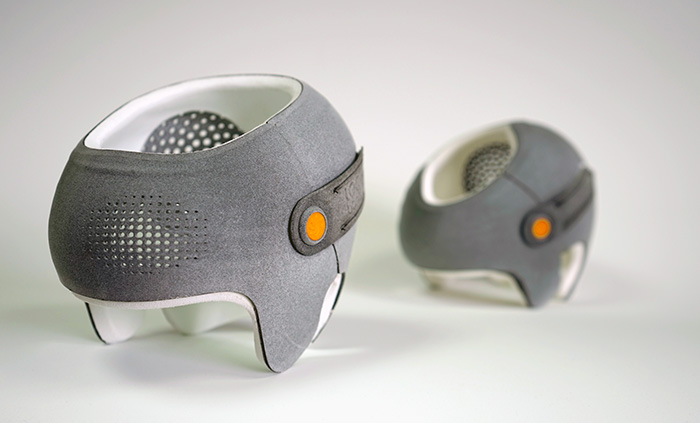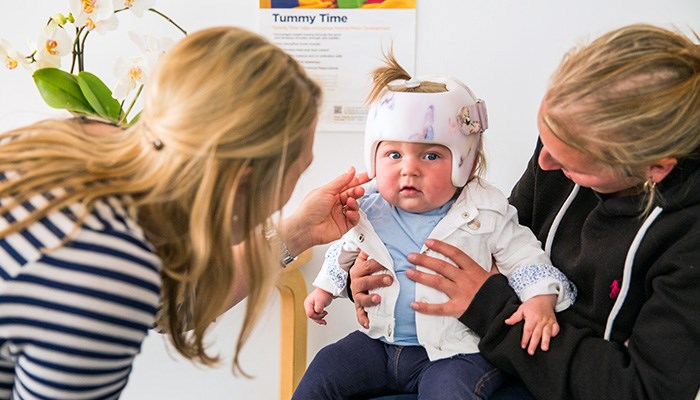Positional Plagiocephaly is a term used to describe the asymmetrical shape of a baby’s skull. It develops as a result of constant pressure being placed on one area of the thin, flexible skull of the baby. Colloquially it is known as ‘flat head syndrome’.
In the USA clinicians also tend to talk about Deformational Plagiocephaly, where the condition is caused by the birth process itself, typically of a firstborn or twins. The lumps and bumps of Deformational Plagiocephaly tend to resolve naturally a few weeks after birth, By contrast, Positional Plagiocephaly can become increasingly apparent.
Until about one year of age, the bones of a baby’s head are very thin and flexible, which makes it soft and easy to mould. Premature babies are more likely to develop flat heads, as their skulls are softer than full-term babies. They also tend to spend more time on their backs without being moved or picked up.
Under the broad heading of Positional Plagiocephaly, there are three main types of asymmetrical head shape: confusingly the first is called Plagiocephaly and the other two are Brachycephaly and Scaphocephaly. You can read more about types of plagiocephaly here.
Positional Plagiocephaly is also known as Flat Head Syndrome.

There are 3 common types of flat head syndrome our clinicians are experienced in treating at LOC.
They are Plagiocephaly, Brachycephaly and Scaphocephaly.
Babies can have one or two different head shapes combined, most commonly Plagiocephaly & Brachycephaly.

Cranial remoulding therapy with a specially manufactured baby helmet is a very effective treatment for Positional Plagiocephaly.
At LOC, we predominantly manufacture and fit the LOCband Lite cranial orthosis which is custom-made and works by applying pressure to pre-defined areas of the skull.

The LOCband Lite has been designed to be lightweight and cooler thanks to modern 3D printing techniques.
It is also made bespoke for each baby to exact clinical specifications.
It has proven results with patients and dramatically reduces weight by 40%, increasing comfort for your baby.
Building upon the success of our original LOCband for treating positional plagiocephaly, we have developed a 3D printed cranial helmet called the LOCband Lite, which features a lighter construction and air vents to improve heat dissipation.
The design has been optimised for 3D printing to enable LOC to create thinner wall thicknesses and utilize state-of-the-art printing techniques to design meshes that allow better air circulation for your baby's head during hotter months.
We listened to parent's needs for a cooler and more lightweight design and after 18 months of trials, we achieved consistent results enabling the successful roll-out of this new cranial helmet.
Find out more about the LOCband Lite.

The London Orthotic Consultancy (LOC) is the most experienced clinic in the UK in treating babies with positional plagiocephaly.
We offer a free, no-obligation, initial consultation for babies aged 3 months and upwards, during which our specialist clinician will establish whether your baby has positional plagiocephaly and how severe it is. We will provide advice about re-positioning techniques that may help to resolve the condition naturally.
In cases of moderate to severe plagiocephaly, cranial remoulding therapy with the LOCband has proven to be very effective at normalising head shape. The LOCband Lite has been designed and perfected by our own clinicians after years of personal experience in treating positional plagiocephaly. Each LOCband Lite is manufactured individually for each baby, according to our clinician’s exact measurements and specifications. Baby helmets like the LOCband have been used for over 25 years to treat babies with flat heads.
Read more about plagiocephaly treatment.


Get to know Victor the Robot, our latest recruit who's a whiz when it comes to carving precision moulds that help LOC Manufacturing achieve better fitting orthoses for conditions such as plagiocephaly, scoliosis and CP.

LOC can print continuous carbon fibre, kevlar and high tensile glass fibres due to our recent investments in 3D print technology. By applying 3D printing techniques to orthotics, we can achieve a number of benefits for our patients.

The advent of carbon fibre has allowed the creation of a new range of specialised orthoses. These are not only lighter and less bulky, but also more comfortable and much stronger than traditional, plastic types.
Victor the Robot, our new computer numerical control milling machine in action! Victor is noisy, but he’s transforming our ability to design and manufacture orthotic devices at our Kingston-upon-Thames clinic.
Manufactured by Rodin4D, Victor is capable of milling complex ergonomic shapes, meaning that we can now potentially assess a spinal orthotic patient, manufacture the orthosis and have it fitted, all in the space of a day. Victor can do everything we need to do for our patients, in-house and in the shortest time possible with no compromise on quality.
This is very much dependent on how fast your baby is growing. The faster the growth, the more frequently your baby will be seen so that the helmet can be adjusted. In general, reviews will happen at two to four-week intervals.
The price of treatment covers:
Yes - All babies that have completed their course of treatment with us have achieved a measurable improvement in head shape. However, you don’t have to take our word for it.
Recent independent research conducted by a University Hospital in Germany has endorsed the treatment for babies with moderate or severe plagiocephaly.
A larger, retrospective study has just been published that found complete correction was achieved in 94.4% of babies treated with helmet therapy.
The results were conclusive: repositioning achieved acceptable correction in 77.1% of cases, but 15.8% were moved onto helmet therapy because re-positioning was not working. Meanwhile, 94.4% of the infants who started in the helmet-treated group achieved full correction, as did 96.1% of those who were transferred from the repositioning group into the helmet-treated group.
Further information can be found on our Plagiocephaly Research page.
If your baby has a temperature or a fever due to illness you must remove the band. The band can be put back on once the temperature has returned to normal.
The optimum age for treatment is between four and seven months.
This is because the skull is most malleable at this age and improvements to head shape tend to take less time and are more dramatic. That is not to say that helmet therapy should be ruled out if the baby is older than seven months. Routinely, babies up to the age of 16 months can be treated very successfully.
The cut off age is around 18 months when the fontanelles (soft spots on the head) are no longer malleable. As babies grow and develop at different rates, it is always worth checking if you are not sure. There have been cases where a baby’s fontanelles have not fused yet by the age of 18 months, who have achieved successful, but less-marked results with cranial remoulding therapy.
Torticollis is a condition in which a tight or shortened muscle in one side of the neck causes the head to tilt or turn to one side, resulting in the infant resting its head in the same position. In 2013, we analysed the data from all first appointments in our Kingston clinic and found that 20% of the babies examined had some kind of neck condition that was causing head immobility.
The clinics and clinicians that provide this treatment in the UK will have received similar training and experience. However, we are the only clinic that manufactures its own helmet and our clinicians are closely involved with the process for each individual helmet that we produce.
In addition, we do not restrict review appointments to a set number, we are extremely flexible and respond to individual parents' needs so that the best outcome can be achieved for each baby.
The LOCband is non-invasive and works by applying gentle, constant pressure over the areas of the baby’s skull that are most prominent while allowing unrestricted growth over the flattened areas. The band consists of a soft foam layer inside a thermoplastic shell. As the baby grows, the band will be adjusted frequently to gently guide the skull into a more symmetrical shape.

Join The London Orthotic Consultancy in celebrating Cerebral Palsy Awareness Day on March 25th. Learn just how important expert orthotic care is in enhancing mobility, independence, and quality of life for children and adults with cerebral palsy.

Introducing the Agilik™ smart orthosis, a cutting-edge, powered knee orthotic now available in the UK through the London Orthotic Consultancy. Unlike traditional KAFOs or heavy exoskeletons, the Agilik™ provides dynamic knee assistance and offers real-time support, reducing fatigue and improving posture. This pioneering, modern technology can help children and adults with lower limb weakness walk more efficiently and naturally. We are honoured to be selected as the exclusive paediatric specialist centre in the UK for the Agilik™ device.

When Sophie noticed her baby Max had a persistent flat spot on his head, she was told it would resolve naturally—but it didn’t. Seeking a second opinion led her to the London Orthotic Consultancy, where Max was diagnosed with severe plagiocephaly.

A little more than four years after the LOCband Lite's launch, we're proud to have successfully treated our 250th helmet therapy patient at our Romford clinic using our cutting-edge 3D-printed cranial band. After five months of treatment, her final scan showed that her asymmetry had decreased from 12 mm to 3 mm.

Sky News published an article this month quoting scientists at Southmead Hospital who claimed there was a lack of research into flat head syndrome and its treatment with cranial remoulding (helmet) therapy. This is our response.

With our non-surgical treatment plan, Alex achieved 100% chest correction in just two years. His treatment involved a combination of dynamic chest compressor and vacuum bell therapy treatment to address his pectus excavatum and rib flaring.

Learn how a custom carbon fibre AFO helped Gill regain mobility and comfort despite complex challenges from shin bone (tibia) removal. We created a truly tailored orthotic solution made from pre-preg carbon fibre at our Cambridge clinic.

Discover how bespoke orthotics and the OSKAR program with Elaine Owen transformed Archie’s life with cerebral palsy quadriplegia, helping him avoid a wheelchair and achieve greater mobility.